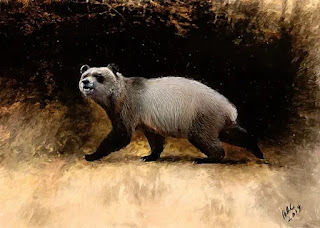Europe’s Last Panda? New Discovery of Species Closely Related to Giant Panda
Reconstruction of A. nikolovi sp. nov. from Bulgaria. Artwork by Velizar Simeonovski, Chicago. Credit: © Velizar Simeonovski, Chicago
Fossilized teeth originally found in the 1970s actually belong to a new, sizeable close relative of the modern giant panda.
A new species of panda has been uncovered by scientists who state it is currently the last known and “most evolved” European giant panda. It lumbered through the forested wetlands of Bulgaria around six million years ago.
Unearthed from the bowels of the Bulgarian National Museum of Natural History, two fossils of teeth originally discovered in the eastern European nation in the late 1970s, provide new evidence of a sizable relative of the modern giant panda. Unlike today’s iconic black and white bear, however, it was not purely reliant on bamboo for sustenance.
“Although not a direct ancestor of the modern genus of the giant panda, it is its close relative,” explains the Museum’s Professor Nikolai Spassov, whose findings are published today (August 1, 2022) in the peer-reviewed Journal of Vertebrate Paleontology.
“This discovery shows how little we still know about ancient nature and demonstrates also that historic discoveries in paleontology can lead to unexpected results, even today.”
The teeth, an upper carnassial tooth and an upper canine, were originally cataloged by paleontologist Ivan Nikolov. He added them to the museum’s trove of fossilized treasures after they were unearthed in northwestern Bulgaria decades ago. This new species is named Agriarctos nikolovi in his honor.
“They had only one label written vaguely by hand,” recalls Professor Spassov. “It took me many years to figure out what the locality was and what its age was. Then it also took me a long time to realize that this was an unknown fossil giant panda.”
The coal deposits in which the teeth were found which have imbued them with a blackened hue suggest that this ancient panda inhabited forested, swampy regions.
There, during the Miocene epoch, it likely consumed a largely vegetarian diet but not purely reliant on bamboo!
Fossils of the staple grass that sustains the modern panda are rare in the European fossil record, especially in the Bulgarian late Miocene period. Additionally, the cusps of the teeth do not appear strong enough to crush the woody stems.
Instead, it likely fed on softer plant material aligning with the general trend toward increased reliance on plants in this group’s evolutionary history.
Sharing their environment with other large predators likely drove the giant panda lineage toward vegetarianism.
“The likely competition with other species, especially carnivores and presumably other bears, explains the closer food specialization of giant pandas to vegetable food in humid forest conditions,” states Professor Spassov.
A. nikolovi’s teeth nonetheless provided ample defense against predators, the paper speculates. In addition, the canines are comparable in size to those of the modern panda, suggesting that they belonged to a similarly sized or only slightly smaller animal.
The authors propose that A. nikolovi may have become extinct as a result of climate change, probably because of the ‘Messinian salinity crisis’. This event, in which the Mediterranean basin dried up, significantly altered the surrounding terrestrial environments.
“Giant pandas are a very specialized group of bears,” Professor Spassov adds. “Even if A. niklovi was not as specialized in habitats and food as the modern giant panda, fossil pandas were specialized enough and their evolution was related to humid, wooded habitats. It is likely that climate change at the end of the Miocene in southern Europe, leading to aridification, had an adverse effect on the existence of the last European panda.”
Co-author Qigao Jiangzuo, from Peking University, China, was primarily responsible in helping to narrow down the identity of this strange beast to belonging to the Ailuropodini a tribe within the Ursidae bear family. While this group of animals is best known by its only living representative, the giant panda, they once ranged across Europe and Asia. Intriguingly, the authors propose two potential pathways for the distribution of this group.
One possible evolutionary trajectory has the Ailuropodini heading out of Asia and concluding in A. nikolovi in Europe. However, Professor Spassov does add caution to this hypothesis, stating that the paleontological data show that “the oldest members of this group of bears were found in Europe.” This suggests that the group may have developed in Europe and then headed to Asia, where the ancestors of another genus, Ailurarctos, developed. These early pandas may then have later evolved into Ailuropoda the modern giant panda.
Source; SciTechdaily.com




Comments
Post a Comment